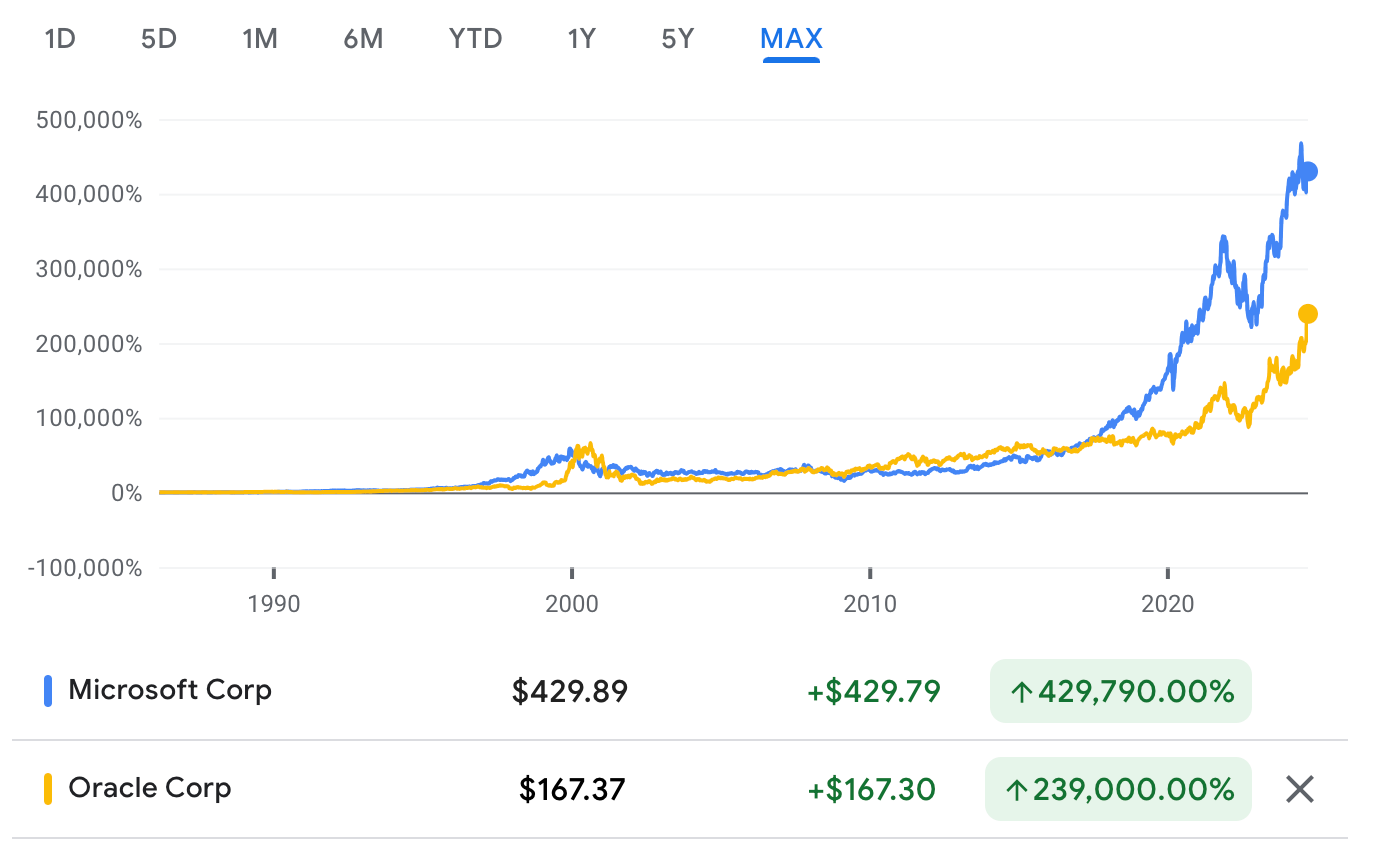Steve Ballmer, Larry Ellison and That Sweet Sweet Tech Equity
The backstories for how the single biggest shareholders in Microsoft and Oracle built their stakes.
Thanks for subscribing to SatPost.
Today, we will discuss how Steve Ballmer became Microsoft’s single biggest shareholder (despite being employee #30) and how Larry Ellison has significantly increased his ownership of Oracle in the past decade (from ~27% to 43%).
PS. If someone sent you this email, subscribe here for weekly breakdowns of business, tech, media and very dumb memes.
There’s a popular Warren Buffet chart that goes viral at least once a month.
It’s some version of his net worth by age with the caption that over 99% of his wealth came after the age of 50. This chart from 2019 ($83B) but Big Daddy Buffett has seen significant gains up to 2024 ($140B-ish).
Now, I may have posted this chart on a social once for engagement farming (ok, twice).
But it is actually one of the better illustrations of taking ownership in an asset (Buffett owns ~16% of Berkshire Hathaway) and letting the magic of compounding work (Berkshire had a market cap of $7.6 million in 1964 and briefly crossed $1 trillion in 2024).
I write this preamble because there have been two centi-billionaire tech stories in recent months:
Steve Ballmer over took Bill Gates on the net worth chart (translation: employee #30 at Microsoft overtook the co-founder).
Larry Ellison briefly topped Jeff Bezos to become 2nd richest person in the world (and is on pace to own more than 50% of Oracle based on the company’s buy back schedule).
Both these tech titans have HODL’d public stock since the mid-1980s, when — in a fun fact of business history — Oracle (March 12, 1986) and Microsoft (March 13, 1986) held IPOs within a day of each other.
Steve Ballmer
On July 2nd, 2024, Steve Ballmer’s net worth ($157.2B) passed Bill Gates ($156.7B) for the first time ever.
When Ballmer joined Microsoft in 1980, he was employee #30 and got zero equity. By the 1986 IPO, he owned 8% of MSFT and is now its single largest shareholder.
How did he get the stake? An interesting contract quirk as detailed by George Anders in a Forbes article.
Ballmer's Microsoft tale began in 1975, his sophomore year at Harvard (he lived down the hall from Bill Gates).
While Gates dropped out to start Microsoft, Ballmer was a total Harvard head: he managed the football team and wrote for The Crimson.
After graduating, Ballmer tried his hands at a few different jobs:
Product Manager at P&G, where he worked with future GE CEO Jeff Immelt
A brief attempt at Hollywood screenwriting
Went to Stanford Business School
While at Stanford, Ballmer was convinced by Gates to drop out and come join Microsoft.
It was 1980 and the software firm was seeing rapid revenue growth. Sales had jumped from $16,000 in 1976 to $8,000,000 in 1980.
Ballmer was Gates' first non-technical hire and the offer he gave reflects the fact that Gates' hadn't recruited a business person before.
This was the deal for Ballmer:
the title of "business manager"
$50k base salary
NO equity
Crucially — as Microsoft was so desperate for sales knowledge — Gates (and co-founder Paul Allen) offered Ballmer "10% of profit growth" he could generate
With Microsoft growing like a weed (it would 2x to $17m in 1981), Ballmer's "10% of profits" deal was not sustainable.
At the time, Microsoft was a partnership (Gates owned 64% while Allen owned 36%).
One early VC (Dave Marquardt) wanted to restructure the corporation for wider stock ownership. Gates wanted nothing to do with the restructuring effort, so Ballmer and Marquardt took the lead (Ballmer was especially keen to get actual equity in the company).
They drafted the following corporate structure:
Gates and Allen own 84%
8% goes to investors
8% goes to Ballmer (in exchange for waiving his 10% profit share deal)
Gates was OK with the deal but Allen was not. Allen wanted Ballmer to own 5% max. So, Gates agreed to drawdown the difference from his own equity stake.
By 1986, Ballmer owned 8% of MSFT. It was worth ~$56m when Microsoft IPO'd at a $700m valuation.
In the decades since, Ballmer — who was Microsoft's high-energy CEO from 2000-2014 — has largely held onto his MSFT equity.
Today, Ballmer owns ~4% of the tech giant while Gates owns ~1% (he has been selling down his stake since the mid-1990s as part of the Giving Pledge).
Larry Ellison
The founder of Oracle has been in the top 10 wealthiest list for decades and recently topped Jeff Bezos after surpassing a $200B net worth for the first time.
Larry Ellison owns 43% of the company, which has benefitted from the AI boom and seen its stock rise 200% over the past 5 years.
Interestingly, Ellison has significantly increased his stake in Oracle over the past decade or so.
At the end of 2010, Oracle was valued at $87B and Ellison owned ~27% of it ($24B).
How did his ownership of Oracle grow so much?
Since 2011, the company has spent ~$155B on buybacks — mostly using free cash flow (with some debt) — and reduced shares outstanding from over 5 billion to under 3 billion.
Ellison didn’t sell into the buyback program and increased his stake from 27% to 43% (he owned 34% of Oracle at its 1986 IPO).
Depending on the pace of buybacks, Ellison could own a majority of Oracle in a few years.







